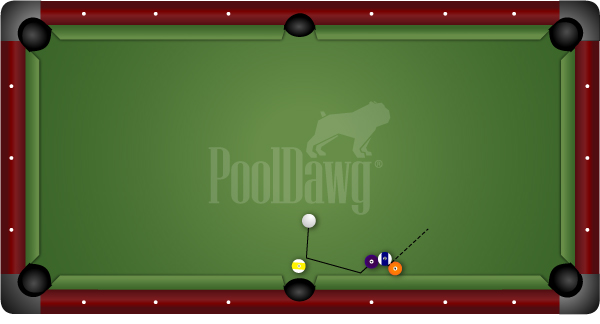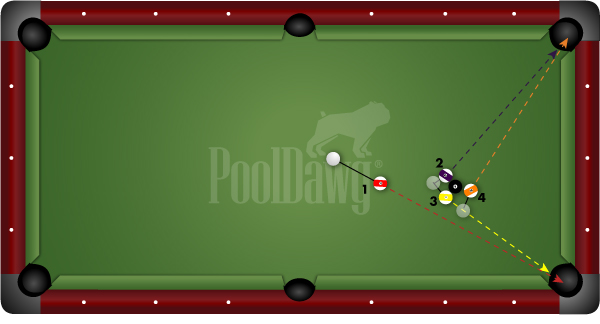One of the most common mistakes I see amateur players make is the way they go about shooting break out shots. Most players eventually identify the problems associated with having one or more balls tied up in a cluster, but the most common misconception is to simply try and slam into them and see what you get. This is a dangerous way of thinking. It leaves your opportunity to win dangling by a thread. In this article I will present a few situations that come up very often, and can be applied to a multitude of shots down the road.
Let’s get started.
In Diagram A, we are playing a game of 8-Ball. Our opponent has fouled and given us ball in hand and we are the stripes. There are several places to start our run, but as you can see we have one problem area. The ten ball is tied up along the rail and I would start out by breaking out that ten ball.
Place the cue ball as shown to pocket the nine ball into the side pocket. Now the reason I chose this angle is to make sure that I hit the rail, then kick into the back of the four ball. The four ball will hit my ten ball and carom it off of the five ball, sending it along the dotted line shown. The cue ball should then come back out towards the middle of the table, where I have my choice of several shots to start my run out.
The key here is speed control. We only want to hit the shot hard enough to drive the ten ball out to where we can make a shot. If we hit this particular shot too hard, all the balls in the cluster will be moving around and could possibly tie up or block the path of other balls. If we pay attention to where we hit the cluster, and where the balls are going, we can control all the balls and achieve more consistent results.

Diagram B shows a different scenario where we have several of our stripes clustered together near the rack area. If you had ball in hand your first instinct might be to play the eleven ball in the corner and blast the cue ball into the cluster and try to spread it apart. This is not a bad idea but it is a reckless idea. It is very hard to know exactly where the balls will end up.
I propose a different solution!
On closer examination we can actually play this sequence without breaking out the balls. This is a more productive solution because we only have to control the cue ball from shot to shot, and we leave nothing to chance. If we shoot the eleven ball first and stop the cue ball, we are straight in on the twelve ball. We can now play the twelve ball in the corner as shown. Once these two balls are out of the way, we now can make the nine ball in the corner pocket and follow down a little bit for the thirteen ball in the corner. Sometimes breakouts are not even necessary.
The key is to look carefully at a cluster and see if by playing one of the open balls in the cluster it will open the cluster up enough for you to maneuver around and won’t have to break open the cluster further. Remember, when you move balls around you are more likely to get into trouble.

Things to remember about break out shots:
1. Don’t just slam into the cluster
2. Use good speed control to only move the balls apart enough so that you can pocket that ball. (the more balls you run into and move, the more trouble you can get into)
3. Analyze the cluster, sometimes we don’t even need to break them out.
If you start to look at clusters in this manner, you will have much more success with controlled break outs and cluster management.